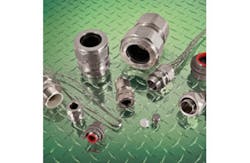Stainless steel electrical connectors are likely not something most people give much thought. They are commodity components that do not get much attention. After all, they’re just small pieces of very large water and wastewater treatment systems — until they fail.
Corrosion, extreme temperatures, chemical seepage and electrical shorts are just the beginning of potential disaster. Production downtime, safety issues and contamination problems result when just one connector goes bad.
Ensuring performance
With such small components doing very large jobs, using the right one is absolutely critical. The whole system runs more smoothly with the right pieces. Since there is so much riding on water treatment systems, primarily the safety of drinking water for millions of people, using sub-standard components should never be an option. Although other materials could be used to reduce the initial cost, they are ferrous-based and corrode much more easily. The long-term maintenance costs are higher and so is the risk of potential contamination and production downtime.
- Aluminum components do not resist some chemicals and are susceptible to pitting
- Zinc coatings and galvanized steel are not easily repaired and, therefore, need more frequent replacement.
Corrosion resistance is paramount in water treatment plants. From harsh chemicals to fresh water, there is potential corrosion everywhere. The two main types of corrosion that occur are micro-biologically influenced corrosion (MIC) and abrasive corrosion.
- MIC is responsible for very high corrosion rates that quickly wear out a system in a short time if left untreated. Depending on the type of stainless steel used, it mandates frequent cleaning and chemical biocide treatment
- Abrasive corrosion comes from mechanical wear in any environment and can be combated by using better materials.
Too many times, however, engineers try to fit a square peg into a round hole when it comes to electrical connectors. Instead of starting with connectors that work perfectly with the system, they change the system to work with the connector. Typically this happens because most manufacturers offer only a few stock stainless steel connectors. Even the big ones only have a few options in stock. If they do create custom connectors, they are only cost-effective in large production runs.
Two big problems result: Re-engineering systems to work with those basic connectors, or lengthening downtime because of shipping delays. Both problems come with very big costs.
The benefits of stainless steel connectors
Stainless steel connectors are crucial components in any large system, but especially for the water and wastewater processing industry. Much of the equipment is exposed to destructive and corrosive elements, so stainless steel components are preferred for their corrosion-resistance, durability and low maintenance.
The right stainless steel connectors help water and wastewater processors to:
- Reduce corrosion in electrical systems and protect from liquids
- Maintain power systems for continuous operation with less downtime
- Protect electrical systems in hazardous and high heat areas
- Deliver less engineering problems and work-arounds
- Experience fewer technical issues
- Lower lifetime installed costs.
Stainless steel should be considered because of its durability in the harsh environments of water and wastewater treatment; its high corrosion resistance, low maintenance and high reliability, ease of fabrication, lifecycle sustainability and top-notch level of safety make it ideal for all types of applications. There are two main types: Type 304 stainless steel is preferred for dry, above water applications because of its general corrosion resistance and lower cost and Type 316 stainless steel is typically used for submersed, underwater applications because of its high corrosion resistance generated by the molybdenum it contains.
Stainless steel not only resists the damaging effects and lasts longer than other alloys, but it is also 100 percent sustainable during its entire lifecycle. Also, since it is naturally corrosive resistant because of inclusion of chromium, there are no harmful chemicals used to fabricate components and it does not give off harmful elements during use or recycling. Further, it has a very minimal impact on water, air and carbon use, plus is recyclable at the end of its effective use.
And, from fabricators who create the components to water treatment plants who experience a very low cost of installation and maintenance to the people who recycle it at the end of its life, stainless steel is a profitable material to work with.
Fabricating stainless steel is also easy, allowing manufacturers to create components to the specifications of plant engineers. With so many options for the right stainless steel connector, it is in the best interest of engineers to seek out a manufacturer who can meet their exact requirements.
This article is courtesy of Remke.


